Research shows people who practiced yoga for migraine for three months experienced fewer and milder migraines than those who only took medicine.
Chronic migraine calls for both long-term therapy and prevention measures. In addition to non-pharmacological methods, acute and preventative medication is used to treat migraines. Yoga is a mind-body exercise that includes meditation, deep breathing, and asanas.
Table of Contents
ToggleHow Yoga Treats Migraine
One of the most crucial parts of treatments for migraine headaches is nonpharmacological treatment. When it comes to complementary therapies, yoga for migraine pain is one of the most significant and successful forms of treatment.
A study has shown that Yoga Nidra, a significant type of yoga, contributes significantly to mental relaxation and is the cause of alpha dominance in the brain. One of the best yoga practices for preparing the mind for yogic discipline and both physical and mental relaxation is yoga nidra.
Yoga for migraine headaches might lower prescription costs while improving overall health. Migraine is characterized by throbbing cranial pain, which may be accompanied by vomiting, nausea, sensitivity to light, and sound, and temporary neurological symptoms.
Headache episodes and the hangover phases of migraine are known to affect the quality of life and job productivity. Additionally, it raises the risk of ischemic cardiovascular and brain illnesses.
Yoga Poses For Migraine Pain Relief
Surya Namaskara
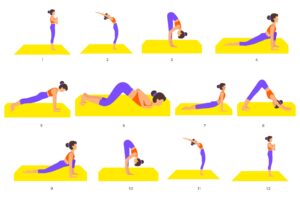
-
- Prayer Pose (Pranamasana) – Inhale, standing tall with the feet together. Place your palms together in front of your chest in a prayer pose.
-
- Raised Arms Pose (Hasta Uttanasana) – Exhale, and extend the arms upward. Gently lean back and stretch the spine while maintaining an upward or forward look.
-
- Hand to Foot Pose (Pada Hastasana) – Exhale, bend forward from the hips, and place your hands on each side of your feet on the mat. Slightly bend the knees for comfort if required.
-
- Equestrian Pose (Ashwa Sanchalanasana – Inhale and step the right foot back into the lunge pose while maintaining a 90-degree bend in the left knee. Open up the chest.
-
- High Plank (Dandasana) – Exhale and bring the left foot back to meet the right foot, forming a high plank. Maintain a straight body and contract the core.
-
- Eight-Limbed Pose (Ashtanga Namaskara) – Lower the knees, chest, and chin to the mat, and raise the hips. Place the elbows close to the chest.
-
- Cobra Pose (Bhujangasana) – Inhale, glide forward, bringing the chest off the mat. Maintain your palms firmly planted on the floor. Pull back the shoulders and open the chest.
-
- Downward Facing Dog Pose (Adho Mukha Svanasana) – Exhale, raise the hips, and tuck the toes in to form an inverted “V” with your body. Press the palms into the mat.
-
- Equestrian Pose (Ashwa Sanchalanasana) – Exhale, bring the right foot forward between your hands to lunge again. Raise your head and spread your chest.
-
- Hand to Foot Pose (Hasta Padasana) – Exhale, step your left foot forward to meet the right foot, folding forward from the hips. Bring your hands down to touch the mat.
-
- Raised Arms Pose (Hasta Uttanasana) – Inhale, extend the spine, and arch your back gently as you sweep your arms high.
-
- Prayer Pose (Pranamasana) – Exhale, and come to a standing posture with the feet together in a prayer pose.
-
- Perform 5-8 rounds of Surya Namaskara daily to prevent chronic migraine.
Child Pose
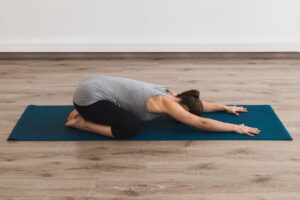
-
- Place your knees slightly apart on the ground.
- Exhale and bend forward. Slightly tuck your chin.
- Extend the arms on the ground in front or extend them back toward the feet, palms up.
- Let the weight of the shoulders stretch the shoulder blades widely across the back.
- Breathe gently and deeply for 30 seconds in Child Pose.
Rabbit Pose
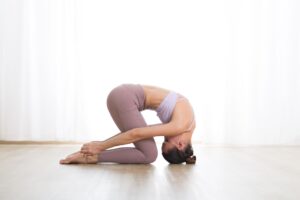
-
- Kneel on the mat.
- Start with the knees hip-distance apart. Place the tips of the feet down.
- Inhale and extend your hand back to cup your heels or to clasp the ankles.
- Exhale and bend forward to rest the top of the head on the floor.
- Lower the chin near the middle of the collarbones.
- Maintain an average pace of breath for 30 seconds in this position.
- To release the pose, bring the head up and come to sit in the kneeling posture in Vajrasana by lowering the buttocks back toward the heels.
Bridge Pose
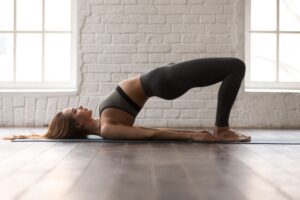
-
- Lie on the back. Bend your knees.
- Spread your legs with your feet flat on the ground.
- Stretch your arms out to each side of your body to touch the back of the heels
- Gently raise your hips up
- Tuck your chin in slightly toward your chest, which helps lengthen the back of your neck.
- Put your hands under the back in an interlace
- Engage your inner thighs and relax your glutes.
- Hold for 30 seconds.
Legs Up The Wall Pose
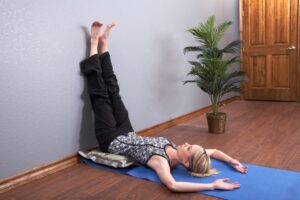
-
- Sit beside the wall with the legs extended
- Lie down to turn towards the wall and extend your feet up the wall
- Place the head on the mat or a pillow
- Adjust to point the tailbone toward the wall
- Hold the pose for 30 seconds.
- Bring your legs down to one side to release the posture.
Sukshma Vyayama for Migraine
The set of exercises releases energy blockages and loosens joints. The stretches are coordinated with breathing. They strengthen the muscles and joints while mobilizing them. This yoga for migraine mainly involves gentle stretches like neck rotations, shoulder rolls, ankle rotations, and knee bending.
Neck Rotation
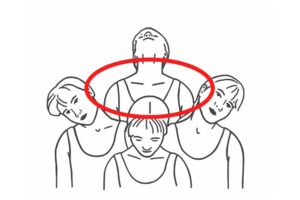
Variation 1- Move the head up to look up. Bring the head down touching the chin to the chest.
Variation 2 – Move the neck to look right and then right.
Variation 3 – Gently rotate the neck to move clockwise and anticlockwise.
Shoulder Rotation

-
- Place the right palm on the right shoulder and the left palm on the left shoulder.
- Raise both arms to roll the shoulder backward and forward.
- Perform it to roll the shoulders 5 times forward and 5 times backward.
Ankle Rotation

-
- Sit in the Dandasana pose. Extend the leg.
- Rotate both ankles clockwise and anticlockwise.
Knee Bending

-
- Sit in Dandasana. Extend the leg in front
- Interlock your arms underneath the thigh for support
- Raise the legs off the floor and bend the right knee,
- Straighten the leg, maintaining the leg off the ground
- Perform for 5 rounds with both legs.
Yoga Nidra for Migraine

It is believed that mindful yoga for migraine is one of the best treatments for pain, exhaustion, insomnia, and psychological distress. In malignant pain situations, relaxation techniques like Yoga Nidra have been shown to reduce the need for medication, enhance sleep quality, and lessen tiredness.
The most well-known method for achieving total physical, mental, and emotional relaxation is yoga nidra. Yoga Nidra is performed while lying on one’s back in Savasana and under the guidance of a yoga therapist.
Through Yoga Nidra, one learns to reach the condition between sleep and waking state without losing awareness. It’s a kind of “sleep” in which all worries let go to achieve a blissful state of consciousness and a level of relaxation.
When compared to other brain waves, the yoga nidra intervention in a study showed improvement in the alpha waves. An increase in alpha wave frequency decreases anxiety, depression, and managing chronic pain.
The practice primarily addresses concentration and withdrawal of sensation. The deepest levels of the mind are opened by Yoga Nidra practice.

